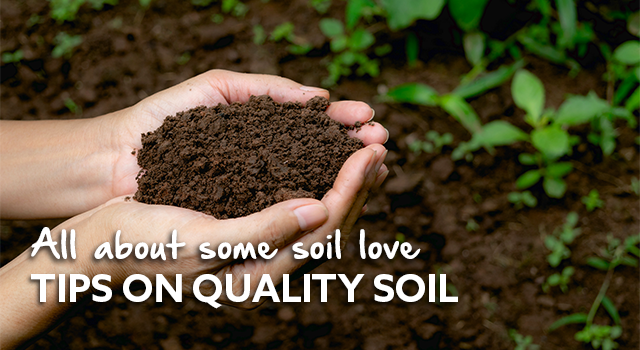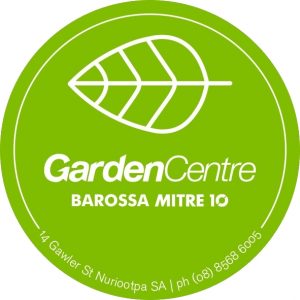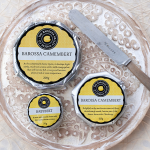All About Some Soil Love

All about some soil love
If I could ever give anyone good advice on having a healthy easy-care garden it is to put most of your time, effort and money into building a good rich soil. It’s vital for the health and well-being of our plants, just as we feed and nurture our plants, we must feed and nurture our soil. Healthy soil equals healthy plants!
Most people want a low maintenance garden, this is easier to achieve if you look after your soil. The best soil for most plants to reach optimum growth is a well-drained but moist soil. Achieving this can be a bit of an effort, whether you have to enrich a poor soil or work to eliminate drainage and compaction problems in heavy clay soils.
Generally soil can be classified into clay, loam and sand. Organic matter is the key to improving each soil types. By adding organic matter it improves soil structure, aids aeration and drainage encouraging soil life which in turn adds nutrients to the soil, keeping soil moist without becoming waterlogged.
Organic matter is a combination of compost which you can buy or make yourself, and composted manures which you can buy by the bag including cow and chicken based manures. The addition of plenty of organic matter brings in the earthworms and other micro-organisms, breaking it down to make food for the plants. In turn the worms moving through the soil aerates it so the plants roots can breathe.
COMPOST
Compost can be confusing. We all know it’s good for the garden but how good? When should it be used? Do we even need to use it? Many well intentioned composters keep adding garden and kitchen scraps to the compost bin and wonder why they are left with a rotten smelly mess.
Compost is the home to millions of active micro-organisms breaking down the organic matter into plant nutrients. Simply, compost adds nitrogen to the garden which the plants need for healthy green growth.
Good compost is a balance of a “brown” carbon/”green” nitrogen ratio. 30 brown to 1 green. Brown materials high in carbon include paper (no glossies), untreated sawdust, dried leaves, cardboard and hay. Green materials are things high in nitrogen including lawn clippings, fresh manures and vegetable scraps.
Newer compost needs more time to breakdown, with nitrogen not readily available for plants to use because it’s being used by the micro-organisms trying to digest the material. Older compost which has been more thoroughly broken down has its nutrients ready to go. Either way the compost will, once applied, continue to break down and decay into a nutrient rich dense soil. When using homemade compost or if compost is still full of green matter, add it in autumn, it will be mostly composted by spring and ready for planting. Bagged ready-to-use compost is always available and especially easy to use. Just add in layers of 5 centimetres in early spring and throughout summer.
THE SET UP
- Choose a well-drained spot in full sun, shade is fine but use less moisture.
- Prepare the material by placing a layer of high carbon material such as chopped woody mulch, leaves and twigs into the base until it’s about 300mm deep.
- Water this layer well.
- Add two to three shovel s of rich ready-made compost or rich healthy soil from the garden or a Tumbleweed Compost Starter Block and a couple of shovels of composted manure to the mix. This will “seed” the compost, your compost bin and bedding material is now established.
- Every time you add food scraps to your compost you should add the same amount in twiggy, leafy garden materials, this provides diversity and aerates the compost. Be sure to sprinkle a teaspoon of Tumbleweed Worm Farm & Compost Conditioner in it every week to stop it becoming too acidic.
- Mix, mix, mix! At the very least once a week, use an aerator or the Tumbleweed Compost Mate to aerate the mix to allow oxygen into the compost heap aiding the microbes to decompose the material quickly and efficiently. If there is not enough oxygen the microbes will just produce bad smells, if this happens add some more twiggy matter and mix, mix, mix!
- It takes six to eight weeks for organic waste to turn into compost. Don’t add any more material in this time just mix every week and ensure it remains moist. When it’s ready it will smell earthy and look like a dark brown, rich, clumpy soil.
ADD OR NOT TO ADD
- Dairy, fish bones or meat scraps – you can, but be warned they are slow to decompose, will smell bad and attract pests, so maybe try to avoid.
- Office Paper – no if it’s been bleached or glossy.
- Weeds – yes but only without seed heads. If they have bulbs or runners such as couch then you should avoid.
- Dog and Cat poop – no there is a significant risk of disease so don’t use it.
- Tree Branches – healthy wood yes, but in shredded form.
- Eucalyptus leaves – yes, they are slow to decompose so run over them with the mower first.
- Lawn clippings – yes but not in large quantities, remember the ratio of 30 brown to 1 green so add newspaper, untreated sawdust or dried leaves as you go.
- Takeaway Pizza boxes – yes, tear them up first
- Citrus fruit – no, these slow down the composting process because they are highly acidic and slow to decompose.
- Coffee Grounds and teabags – coffee no problem, teabags yes, as long as all materials on teabag is plastic /synthetic free, the staple will add a bit of iron.
- Newspaper – yes, but its better shredded, it composts faster, no glossy inserts.
- Eggshells – yes, they should be crushed but decompose slowly.
- Diseased plant material – no, this will perpetuate disease in your garden.
What products are best to create a healthy soil?
Find out more.





